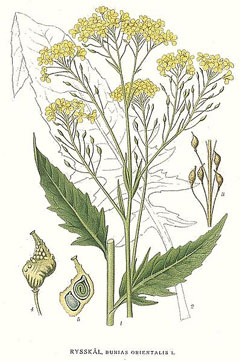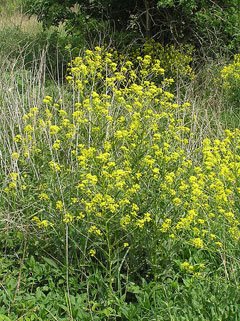 |
|
http://commons.wikimedia.org/wiki/File:202_Bunias_orientalis.jpg |
 |
| http://commons.wikimedia.org/wiki/User:Don_Pedro28 |
Translate this page:
Summary
Physical Characteristics

 Bunias orientalis is a PERENNIAL growing to 0.9 m (3ft) by 0.5 m (1ft 8in).
Bunias orientalis is a PERENNIAL growing to 0.9 m (3ft) by 0.5 m (1ft 8in).
See above for USDA hardiness. It is hardy to UK zone 7 and is not frost tender. It is in flower from May to August, and the seeds ripen from July to September. The species is hermaphrodite (has both male and female organs) and is pollinated by Bees, flies. The plant is self-fertile.
Suitable for: light (sandy), medium (loamy) and heavy (clay) soils. Suitable pH: mildly acid, neutral and basic (mildly alkaline) soils. It cannot grow in the shade. It prefers moist soil.
UK Hardiness Map
US Hardiness Map
Synonyms
Plant Habitats
Woodland Garden Sunny Edge; Dappled Shade;
Edible Uses
Edible Parts: Flowers Leaves Stem
Edible Uses:
Leaves and young stems - raw or cooked[17, 61, 105, 177, 183]. The young leaves have a mild cabbage flavour that goes very well in a mixed salad, though some people find them indigestible[K]. The leaves are a bit hairy so we find them less than wonderful when eaten raw on their own[K]. The cooked leaves make an excellent vegetable[K]. The leaves are available early in the year, usually towards the end of winter, and the plant will continue to produce leaves until late autumn, with a bit of a gap when the plant is in flower[27, K]. Flower buds and flowering stems - raw or cooked[264]. A pleasant mild flavour with a delicate sweetness and cabbage-like flavour, they make an excellent broccoli substitute though they are rather smaller[K].
References More on Edible Uses
Medicinal Uses
Plants For A Future can not take any responsibility for any adverse effects from the use of plants. Always seek advice from a professional before using a plant medicinally.
None known
References More on Medicinal Uses
The Bookshop: Edible Plant Books
Our Latest books on Perennial Plants For Food Forests and Permaculture Gardens in paperback or digital formats.

Edible Tropical Plants
Food Forest Plants for Hotter Conditions: 250+ Plants For Tropical Food Forests & Permaculture Gardens.
More

Edible Temperate Plants
Plants for Your Food Forest: 500 Plants for Temperate Food Forests & Permaculture Gardens.
More

More Books
PFAF have eight books available in paperback and digital formats. Browse the shop for more information.
Shop Now
Other Uses
References More on Other Uses
Cultivation details
A very easily grown plant, it succeeds in any soil in a sunny position[1, 200]. Plants have also been seen growing exceedingly well in the dappled shade of a woodland garden[K]. Plants are quite tolerant of neglect, growing well amongst long grass on our Cornish trial ground[K]. The young spring growth can be quite badly damaged by slugs, though more mature plants grow away so quickly that this does not seem to be a problem[K]. For polyculture design as well as the above-ground architecture (form - tree, shrub etc. and size shown above) information on the habit and root pattern is also useful and given here if available. The plant growth habit is a clumper with limited spread [1-2].
References Carbon Farming Information and Carbon Sequestration Information
Temperature Converter
Type a value in the Celsius field to convert the value to Fahrenheit:
Fahrenheit:
The PFAF Bookshop
Plants For A Future have a number of books available in paperback and digital form. Book titles include Edible Plants, Edible Perennials, Edible Trees,Edible Shrubs, Woodland Gardening, and Temperate Food Forest Plants. Our new book is Food Forest Plants For Hotter Conditions (Tropical and Sub-Tropical).
Shop Now
Plant Propagation
Seed - sow April in a cold frame. Germination is usually very quick and good. Prick out the seedlings into pots as soon as they are large enough to handle and plant them out in early summer. The seed can also be sown in situ in the spring, though the seedlings are rather prone to slug damage[K]. Division in spring. Quick and easy. Root cuttings 2 - 5cm in length succeed at any time during the growing season, though early spring as the plant comes into growth is best[K]. If the top 7 - 10cm of the plant is removed to supply root cuttings and divisions, the roots remaining in the soil usually regrow very quickly[K].
Other Names
If available other names are mentioned here
Native Range
TEMPERATE ASIA: Armenia, Azerbaijan, Ciscaucasia, Georgia, Iraq (north), Russian Federation-Ciscaucasia, Russian Federation-Western Siberia, Turkey, Western Siberia (southwest),Iran (northwest). EUROPE: Hungary, Russian Federation-European part, European part (south), Belarus, Moldova, Ukraine (incl. Krym), Bulgaria (east), Romania, Serbia (northeast),
Weed Potential
Right plant wrong place. We are currently updating this section.
Please note that a plant may be invasive in one area but may not in your area so it's worth checking.
Conservation Status
IUCN Red List of Threatened Plants Status :

Growth: S = slow M = medium F = fast. Soil: L = light (sandy) M = medium H = heavy (clay). pH: A = acid N = neutral B = basic (alkaline). Shade: F = full shade S = semi-shade N = no shade. Moisture: D = dry M = Moist We = wet Wa = water.
Now available:
Food Forest Plants for Mediterranean Conditions
350+ Perennial Plants For Mediterranean and Drier Food Forests and Permaculture Gardens.
[Paperback and eBook]
This is the third in Plants For A Future's series of plant guides for food forests tailored to
specific climate zones. Following volumes on temperate and tropical ecosystems, this book focuses
on species suited to Mediterranean conditions—regions with hot, dry summers and cool, wet winters,
often facing the added challenge of climate change.
Read More
Expert comment
Author
L.
Botanical References
50200
Links / References
For a list of references used on this page please go here
Readers comment
© 2010, Plants For A Future. Plants For A Future is a charitable company limited by guarantee, registered in England and Wales. Charity No. 1057719, Company No. 3204567.